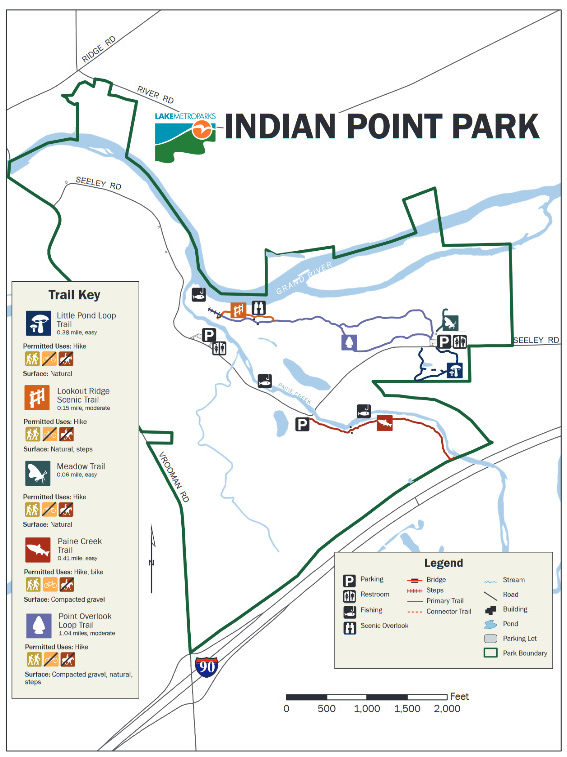Indian Point Park--Upper Lot Entrance
Indian Point Park--Upper Lot Entrance
13165 Seeley Road Leroy Township, Ohio 44077
Indian Point Park Official WebsiteIndian Point Park map
Western Reserve Land Conservancy Parks and Preserves webpage
Grand River Public Access Guide
Also, see all the hotspots at:
Grand River-Lower Watershed Important Bird Area
About Indian Point Park
See all hotspots at Indian Point Park
The park has undergone vast improvements very recently. Seeley Road between the upper and lower lots has been permanently closed and is now a perfect place from which to bird alongside Paine Creek. When the new bridge on Vrooman Road opened, Lake Metroparks opened additional access to the park featuring a new parking area, playground, picnic areas, and access to a new pedestrian bridge spanning the Grand River. The new pedestrian bridge, just a three-minute walk from the parking lot on a paved trail, offers spectacular views of the Grand River. Future plans include the addition of trails to provide connections and more access within the park.
The river corridor and tall tree canopy attract songbird migrants, but it’s the breeding birds that are the main attraction here. You have all summer to search for Louisiana Waterthrush, Cerulean, Yellow-throated, and Hooded Warblers that nest at Indian Point. Birds such as Dark-eyed Junco, Winter Wren, Canada Warbler, and Magnolia Warbler which are typically associated with boreal forests are attracted to the cooler micro-climates where the hemlocks grow. Northern Rough-winged Swallows nest in the steep banks along Paine Creek, the upper lot area has nesting records of Yellow-breasted Chat and even a Brewster’s Warbler, and Common Mergansers have been known to nest along the Grand River.
The Lower Lot Entrance is located at 12951 Seeley Road, the Upper Lot Entrance is at 13165 Seeley Road., and the new West Lot is at 12701 Seeley Road. Pit or portable restrooms are available at all three parking lots. Flooding may cause the campsite to be closed. Much of the trails are improved surfaces and are flat except for the 100-foot difference in elevation between the upper and lower areas.
Listed on the National Register of Historic Places by the National Park Service, Indian Point has one of the earliest architectural works in this part of Ohio.
A tribe from the Whittlesey Culture lived here; a Whittlesey structure was built on the 100-foot ridge between Paine Creek and the Grand River. Two parallel mounds of their earthworks can be seen. The Whittelsey were an early people who lived from 900 AD to 1650 AD in stockade villages on high bluffs overlooking rivers and lakes. Because they had no contact with Europeans, the name of their tribe is unknown. The culture is named after the archaeologist who discovered the tribe.
Charles Lyman bought several acres at the Point in 1901. He had camped here often. In the years before World War I, he used the area as a military camp for high school boys. More than 150 youngsters attended Lyman’s Camp Wissolohican during its seven-year period of existence. Lyman began carving the names of campers into a Totem Stone, which can be seen along the trail near the point. Later, the point became a Finnish camp, Kaleva Lodge. During this time, a stone hut was built and used as a sauna, intact until the 1970s, when the park system dismantled it. The property was purchased from John Phelps in 1964. A plaque was erected here, in honor of James and Edna Phelps, his parents. (In 1802, part of the property had been deeded to his ancestors by the Connecticut Land Company.)
Western Reserve Land Conservancy helped Lake Metroparks add 74 acres of beautiful upland, slope, and floodplain forest habitats to their 494-acre Indian Point Park located along the scenic Grand River. The land has a rich history of usage including as a native American stockade village sometime between 900 AD and 1650 AD, as a Finnish camp in the mid-1800s, and as a military camp for high school boys in the early 1900s. The park is listed on the National Register of Historic Places by the National Park Service for having one of the earliest Native American architectural works in this part of Ohio, including two parallel earthwork mounds built by a tribe from the Whittlesey Culture. The park also provides opportunities for grilling, picnicking, limited biking, canoeing/kayaking, fishing, and hiking. Pit toilets are available in the parking areas.
Features
Restrooms on site
Wheelchair accessible trail
Entrance fee
Roadside viewing
Content from Indian Point Park Official Website, Western Reserve Land Conservancy Parks and Preserves webpage, and Ohio Ornithological Society, Sarah Preston
